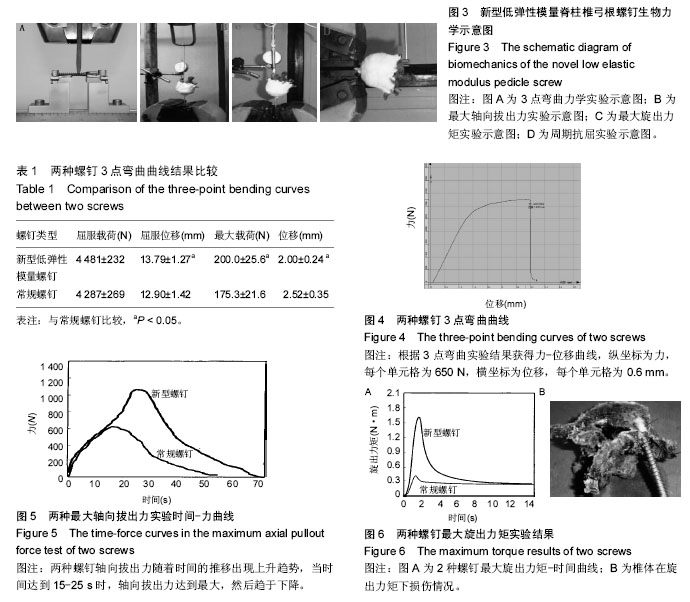| [1] 李振伟,向阳明.生物力学评价颈椎前路椎弓根螺钉植入骨质疏松椎骨内的稳定性[J].中国组织工程研究,2015, 19(35):5718-5722.[2] 周章彦,朱轶,连福明,等.颈后路椎弓根钉技术治疗寰枢椎创伤性失稳[J].中国医师杂志,2012,14(3):342-343.[3] 林焱斌,林伟,林任,等.改良组合术式治疗复杂胫骨平台骨折的疗效分析[J].中华创伤骨科杂志,2014,16(7): 632-635.[4] Wu AM, Wang XY, Chi YL, et al. Management of acute combination atlas-axis fractures with percutaneous triple anterior screw fixation in elderly patients. Orthop Traumatol Surg Res. 2012;98(8):894-899.[5] 刘伟军,王俊文,黄玉成,等.专家型胫骨髓内钉治疗复杂性胫骨近端骨折[J].中华创伤骨科杂志, 2014,16(3): 265-267.[6] Kato S, Hozumi T, Yamakawa K, et al. META: an MRI-based scoring system differentiating metastatic from osteoporotic vertebral fractures. Spine J. 2015; 15(7):1563-1570.[7] 朱晓文,陈建庭.狄诺塞麦对低骨量妇女腰椎骨密度的影响及其安全性的 meta 分析[J].南方医科大学学报, 2013, 33(6):913-917.[8] 陈作喜,黄义星,黄皆和,等. 颈胸段前路内固定器械的相关 MRI影像解剖学研究[J].温州医学院学报, 2013, 43(11):701-705.[9] 徐彦芳,孙进,周初松,等.全内置式可膨胀型脊柱前路内固定系统研制的解剖学基础[J].实用医学杂志,2013,29(3): 352-354.[10] Chen LX, Li YL, Ning GZ, et al. Comparative efficacy and tolerability of three treatments in old people with osteoporotic vertebral compression fracture: a network meta-analysis and systematic review. PLoS One. 2015; 10(4):123-153.[11] Edidin AA, Ong KL, Lau E, et al. Morbidity and mortality after vertebral fractures: comparison of vertebral augmentation and nonoperative management in the medicare population. Spine (Phila Pa 1976). 2015;40(15):1228-1241.[12] Xiao H, Yang J, Feng X, et al. Comparing complications of vertebroplasty and kyphoplasty for treating osteoporotic vertebral compression fractures: a meta-analysis of the randomized and non-randomized controlled studies. Eur J Orthop Surg Traumatol. 2015;251(53):S77-S85.[13] Zou J, Zhang W, Zhang CQ. Comparison of minimally invasive percutaneous plate osteosynthesis with open reduction and internal fixation for treatment of extra-articular distal tibia fractures. Injury. 2013;44(8): 1102-1106.[14] 高群兴,张盛强,朱干.推拿配合调曲牵引治疗腰椎间盘突出症疗效与腰椎生理曲度的相关性[J].按摩与康复医学, 2014,32(8):35-37.[15] Zou J, Zhang W, Zhang CQ. Comparison of minimally invasive percutaneous plate osteosynthesis with open reduction and internal fixation for treatment of extra-articular distal tibia fractures. Injury. 2013;44(8): 1102-1106.[16] 李伟,张宏,曹丽君,等.脊柱腰段正常及骨质疏松三维有限元数字模型的建立[J].中国组织工程研究, 2013,17(9): 1521-1526.[17] Smorgick Y, Park DK, Baker KC, et al. Single-versus multilevel fusion for single-level degenerative spondylolisthesis and multilevel lumbarstenosis: four-year results of the spine patient outcomes research trial. Spine (Phila Pa 1976). 2013;38(10):797-805.[18] Wong WH. Mild interlaminar decompression for the treatment of lumbarspinal stenosis: procedure description and case series with 1-year follow-up. Clin J Pain. 2012;28(6):534-538.[19] 卫沛然,邹德威,陈晓明,等.后路减压Dynesys动态固定与后路减压融合内固定治疗单节段腰椎退行性疾病的临床疗效的比较[J].颈腰痛杂志,2014,35(2):90-95.[20] 张阳,李放,单建林,等.Dynesys动态内固定与融合术治疗腰椎退变疾病的对比研究[J].脊柱外科杂志,2014,12(1): 19-24.[21] Han Y, Xia Q, Hu YC, et al. Simultaneously Combined Anterior-Posterior Approaches for Subaxial Cervical Circumferential Reconstruction in a Sitting Position. Orthop Surg. 2015;7(4):371-374.[22] Jia Q, Hu L, Yu Y, et al. Balloon vertebroplasty combined with short-segment pedicle screw instrumentation for treatment of thoracolumbar burst fractures. Zhongguo Xiu Fu Chong Jian Wai Ke Za Zhi. 2015;29(6):741-745. [23] Zhai MY, Wang CP, Liu F, et al. The efficacy of pedicle screw instrument in treatment of irreducible atlantoaxial dislocation. Arch Orthop Trauma Surg. 2015;135(9):1193-1199. [24] Sanpera I Jr, Piza-Vallespir G, Burgos-Flores J. Upper thoracic pedicle screws loss of fixation causing spinal cord injury. J Pediatr Orthop. 2014;34(6):e39. [25] Zaryanov AV, Park DK, Khalil JG, et al. Cement augmentation in vertebral burst fractures.Neurosurg Focus. 2014;37(1):E5.[26] Xiu P, Wang Q, Wang G, et al. Morphological and clinical feasibility of C3 pedicle screw instrumentation in patients with congenital C2-3 fusion. Eur Spine J. 2014; 23(8):1730-1736. [27] Ge C, Hao D, He B, et al. Effectiveness of anterior cervical plate fixation for unstable hangman fracture. Zhongguo Xiu Fu Chong Jian Wai Ke Za Zhi. 2014; 28(6):728-732. [28] Hu Y, Xu RM, Albert TJ, et al. Function-preserving reduction and fixation of unstable Jefferson fractures using a C1 posterior limited construct. J Spinal Disord Tech. 2014;27(6):E219-E225.[29] Lü GH, Li J, Wang XB, et al. Surgical treatment based on pedicle screw instrumentation for thoracic or lumbar spinal Langerhans cell histiocytosis complicated with neurologic deficit in children. Spine J. 2014;14(5): 768-776.[30] Skaggs KF, Brasher AE, Johnston CE, et al. Upper thoracic pedicle screw loss of fixation causing spinal cord injury: a review of the literature and multicenter case series. J Pediatr Orthop. 2013;33(1):75-79. [31] Ma C, Wu JB, Zhao M, et al. Treatment of upper cervical spine instability with posterior fusion plus atlantoaxial pedicle screw. Zhonghua Yi Xue Za Zhi. 2011;91(43):3062-3065. [32] Wang SG, Zhao QH, Xie Y, et al. Treatment of combination atlantoaxial fractures with posterior fusion plus atlantoaxial pedicle screw. Zhonghua Yi Xue Za Zhi. 2011;91(31):2172-2175. [33] Deng WX, Zhao HR, Liu H, et al. Treatment of thoracalumbar fractures with pedicle-screw placement on the level of injured vertebrae. Zhongguo Gu Shang. 2011;24(7):541-543.[34] Machino M, Yukawa Y, Ito K, et al. Posterior/anterior combined surgery for thoracolumbar burst fractures--posterior instrumentation with pedicle screws and laminar hooks, anterior decompression and strut grafting. Spinal Cord. 2011;49(4):573-579. [35] Ma W, Xu R, Liu J, et al. Posterior short-segment fixation and fusion in unstable Hangman's fractures. Spine (Phila Pa 1976). 2011;36(7):529-533.[36] Zhao LJ, Xu RM, Ma WH, et al. Evaluation of the value of pedicle screws for cervicothoracic fracture-dislocation. Orthop Surg. 2010;2(1):27-31. [37] Alosh H, Parker SL, McGirt MJ, et al. Preoperative radiographic factors and surgeon experience are associated with cortical breach of C2 pedicle screws. J Spinal Disord Tech. 2010;23(1):9-14. [38] Zhao LJ, Xu RM, Ma WH, et al. Application of the pedicle screws for cervicothoracic fracture-dislocation. Zhongguo Gu Shang. 2009 Aug;22(8):569-572.[39] Gu YJ, Hu Y, Ma WH, et al. Selective treatment of thoracolumbar fracture with posterior monosegmental pedicle screw fixation. Zhongguo Gu Shang. 2009; 22(7): 491-493.[40] Xu LM, Gu R, Lin Y, et al. Clinical study on multi-segmental pedicle screw implantation in the treatment of middle-upper thoracic spine fracture and dislocation. Zhongguo Gu Shang. 2008;21(8):603-605.[41] Fay LY, Wu JC, Tsai TY, et al. Dynamic stabilization for degenerative spond-ylolisthesis: evaluation of radiographic and clinical outcomes. Clin Neurol Neurosurg. 2013;115(5):535-541.[42] 李江龙,刘继波,周鹏,等.Dynesys动态中和系统和经后路椎间融合术治疗腰椎退行性变的疗效比较[J].中国现代医学杂志,2014,24(28):104-107.[43] 姜文涛,梅伟,王庆德,等.椎管减压结合动态稳定系统 Dynesys治疗腰椎退变性疾病[J].中国实用医刊, 2014, 41(14):82-83.[44] Lee KH, Kang DH, Lee CH, et al. Inferolateral entry point for c2 pedicle screw fixation in high cervical lesions. J Korean Neurosurg Soc. 2011;50(4):341-334.[45] 张立军,马正儒,张华杰,等.锁定钢板治疗56例胫骨远端Pillon骨折的临床疗效观察[J].中国医学创新,2013, 10(14):105-106.[46] Yu W, Zhang C, Zhang B, et al. Cytotoxicitic detection of laser welding between NiTi shape memory alloy and stainless steel in vitro. Zhonghua Kou Qiang Yi Xue Za Zhi. 2014;49(4):239-243.[47] Heravi F, Moayed MH, Mokhber N. Effect of fluoride on nickel-titanium and stainless steel orthodontic archwires: an in-vitro study. J Dent (Tehran). 2015; 12(1): 49-59.[48] 邓必权,胡华,滕宇,等.椎弓根螺钉复位内固定后单纯植骨融合与椎间融合器融合治疗腰椎滑脱症的疗效比较[J].中国老年学杂志,2015,35(7):1823-1825.[49] 韩建华,孙厚杰,周鑫,等.腰椎退行性滑脱症内固定与不同植骨融合方式的疗效比较[J].中国矫形外科杂志,2014, 22(13):1226-1230. |
.jpg)

.jpg)
.jpg)
.jpg)